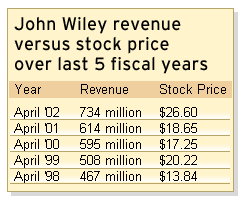NEW YORK (CNN/Money) -
Much like specialized cable channels have thrived in the world of network television by finding their niche, select boutique book publishers have survived the slings and arrows of the publishing industry by targeting a specific, steady customer base.
Granted, watching the movement in companies like John Wiley and Scholastic would perhaps be more akin to watching paint dry than watching a speeding motorcycle. The stocks don't see as much day-to day volatility on economic or geopolitical developments as other sectors do; instead they trade mostly on publishing-industry news and their own company-specific developments.
But what these conservative, traditional companies lack in intrigue, they compensate for with sound fundamentals and a fairly consistent, predictable revenue stream, analysts say.
"Pure-play publishers are able to do well because the companies have a specific market that they're focused on," said T.K. MacKay, a senior stock analyst at Morningstar who follows the industry.

"If these companies are publishing for the professional or children's book market, they don't need one big hit a year," he added. "They might publish hundreds of books that sell 10,000 copies each, and that's fine. They can make a profit because the books tend to be pricier than other kinds of books and because, particularly with universities and other professional markets, institutions have to buy large numbers of these books, whether they want to or not."
Whether the companies are vulnerable to weakness in the economy tends to depend on how big a percentage of their business is in the consumer section, he added.
Certainly, the publishing industry as a whole hasn't been able to avoid the slowdown. U.S. book sales totaled approximately $26 billion in 2002, according to the Association of American Publishers (AAP), the main trade group for the publishing industry. The figure was up 5.5 percent from 2001, but in general, sales have been weak over the last quarter, starting with a slower-than-expected holiday season and continuing through February and March.
AAP spokeswoman Kathryn Blough said non-fiction titles that address certain specific topics, like history and business, seem to be picking up at the moment. Sales for children's hardcover books have been down in the last two months, but the specialty market is less vulnerable to the sluggish economy in that it has a certain built-in source of revenue that fiction or other "non-essential" kinds of books don't necessarily have.
Putting your money where your library is
Take John Wiley & Sons Inc. (JW.A: up $0.55 to $23.55, Research, Estimates), for example. The almost 200-year-old bookseller is known for everything from college textbooks to the "Frommer's" travel guides, "CliffsNotes" and the "For Dummies" series. Because many of its books are informational in nature, come in series and get revised on a fairly frequent basis, profits tend to increase as the company's library expands. The fact that the company has these series and is a staple of college texts gives it a good relationship with vendors like Amazon.com and Barnes & Noble.
In a recent note on the company, Morningstar's MacKay said the stock has returned about 23 percent annually to investors over the past 10 years and should continue to offer strong returns. Morningstar rates it five stars, the highest rating.
The stock's 52-week price range is between $19.26 and $27.63. It has traded steadily in the $22 to $23 range since the start of the war in Iraq three weeks ago.

"John Wiley is probably one of the more successful companies in book publishing," said Constance Sayre, director and owner of Market Partners International, a book publishing consulting firm. "It's focused, well-managed and rarely mentioned as an acquisition target. It's done so well that investors are now paying attention. It's a good example of how if you can find your niche and stay in it, you can do well."
One of the big niche publishing stock stories of late has been Scholastic (SCHL: Research, Estimates). Although it made its name as a publisher of titles for school book clubs, it is now synonymous with Harry Potter, as in the four hugely successful books that carry the young magician's name, for the one percent of consumers who don't already know.
But despite the Harry Potter franchise and other successful titles, Scholastic did see a pullback in its most-recent quarter amid the economic slowdown. The company reported a fiscal third-quarter loss of one cent a share, down from a profit of 31 cents a year earlier but better than the loss of 3 cents a share that analysts had expected.
The stock fell sharply when Scholastic warned that third-quarter results would miss and is down about 23 percent year-to-date. However, since the war started -- which was also the same day that the company reported results -- the stock has held in the $26 to $27.40 range
The company recently reaffirmed its earnings forecast for the fiscal year, saying it expects a profit of $1.85 to $2.15 a share. The fifth Potter book is due June 21 and due to an already strong response, Scholastic has ordered a second run of it, bringing the total number of copies that will be in print to 8.5 million.
Scholastic and John Wiley are among the few specialty firms that are publicly traded. Other profitable boutique companies, like W.W. Norton, remain private.

|

